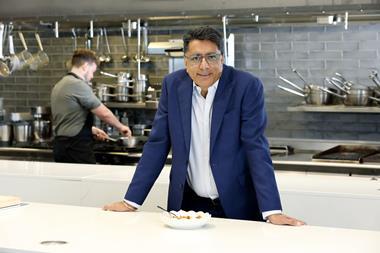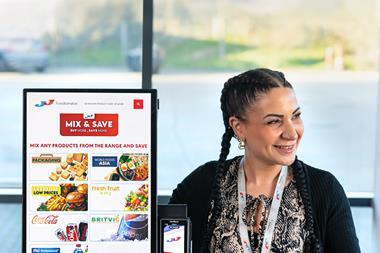Dr Oetker has won Brits over with startling speed. Siân Harrington looks at the man behind the brand
Dr Oetker, the E5bn German food giant, is aiming to attain European market leadership in baking, desserts and pizza within five years. Not bad for a company which was unknown in the UK until March last year. But then Dr Oetker is not your run-of-the-mill company. Founded 112 years ago - international chairman Dr August Oetker is fourth generation family - it appears to be a ragbag of operations without synergy. Indeed, with today’s pressure to divest non-core operations, it would be hard-pressed to survive in its current shape if it were not a family business.
The group, which has 19,000 employees, comprises six divisions. The financial services division includes one of Germany’s largest private banks and an insurance group. Shipping, the biggest operating division with sales just under E2bn, contains a fleet of 100 ships transporting cargo on the north-south trade routes and is Germany’s second largest shipping business. Then there are the hotels, including luxury names like Le Bristol in Paris, a publisher and chemicals factory.
Of more interest are its three food and drink divisions. Within beer it is number two by volume in Germany, with sales of about 10 million hectolitres. The sparkling wine, beer and spirits division is one of the major beverage groups in central Europe. Finally there is the food division, the origins of the group, which has sales of more than E1.3bn.
The 59-year-old international chief is not concerned with the unfashionable status of conglomerate. If anything, he believes this gives the group an advantage and is adamant it will stay private.
“We view it as a strength that we can go our way without having to consider window-dressing in the balance sheet or share prices,” Oetker says. “We will continue to be in a position to finance further development on the basis of sustainable, sound profitability combined with a high earnings retention rate. The Oetker Group therefore has no plans to go public.”
Sales outside Germany make up 55% of group turnover. Oetker personally manages the international business, which operates production or distribution companies in 27 countries. These are primarily in western and eastern Europe, although there is a Brazilian and Canadian presence.
In Italy and France Dr Oetker trades under the Ancel and Cameo brands for historical reasons. Elsewhere, including the UK, the strategic product lines are managed under the Dr Oetker brand, although there are some regional lines resulting from acquisitions. The Dr Oetker logo, the name with a woman’s head integrated into it, reflects the female consumer “at whom all our efforts are directed”, says Oetker.
While diversification allows the group to spread its risk, the strategy for each division is one of focus. For this reason the company has reduced its product lines from 600 to 250 after identifying that it was in danger of overstretching the brand.
“This now generates more energy for the continuing renewal of core product lines. And it boosted sales,” says Oetker.
The group’s entry into the UK market last year took many by surprise, not least because it chose the already crowded and price-driven frozen pizza category for its launch. But as European market leader by sales in branded frozen pizza - it is number one in 10 countries and number two in another four - it has the experience to bring new interest to the category. And it seems to have captured consumers’ imaginations. From a standing start the Dr Oetker Ristorante nine-strong pizza range has grown rapidly. This year alone sales increased from £7m to £16.7m in multiples - a 138% uplift [Information Resources, year to July 2003]. This is at a time when the category declined by 2.4%. The company claims to have a 19% share of the branded thin and crispy market, making it the largest pizza brand in this category, and Pizza Ristorante’s weighted distribution stands at 79% compared with 47% at launch [ACNielsen, July 12, 2003].
Maintaining good distribution in the major multiples is a key aim and the UK division hopes to roll out more of its lines to retailers that only stock two or three. Its frozen Calzone, a UK first launched in September last year, is now one of the best performing products, according to the company.
Following its success in multiples Dr Oetker decided to push into the convenience and independent sector four months ago. According to a UK spokesman, it is now in talks with a number of retailers about listing the range and UK MD Peter Franks is seeking more retailers to work with in this sector.
More recently Dr Oetker has been rolling out a pan-European look for the brand, with a more contemporary image and embossed packaging. Oetker says his strategy is to develop the group as one of the biggest family businesses in Europe by “forcefully expanding some of the operating divisions internationally”.
For Oetker, market leadership is the only game in town and achievement is based on innovation, quality and price. “We cannot and will not enter the contest for cheapest product,” says Oetker. “To safeguard our future we must generate adequate margins - for ourselves and our market. We can if we hold price leadership.”
He is also adamant that the company will not go into own label production because it would weaken its position as a branded food manufacturer.
In these days of global giants, a Europe-focused family business may seem vulnerable but Oetker is confident about the future, even in an age when the rules of the game are being changed by ever-accelerating consolidation. The group’s strategy of going into more countries with fewer product lines, while keeping risks low through diversification, is paying off, says Oetker.
As his father once said to him: “You must not put all your eggs in one basket. Because, if the basket falls…”
Unfashionable status
Dr Oetker, the E5bn German food giant, is aiming to attain European market leadership in baking, desserts and pizza within five years. Not bad for a company which was unknown in the UK until March last year. But then Dr Oetker is not your run-of-the-mill company. Founded 112 years ago - international chairman Dr August Oetker is fourth generation family - it appears to be a ragbag of operations without synergy. Indeed, with today’s pressure to divest non-core operations, it would be hard-pressed to survive in its current shape if it were not a family business.
The group, which has 19,000 employees, comprises six divisions. The financial services division includes one of Germany’s largest private banks and an insurance group. Shipping, the biggest operating division with sales just under E2bn, contains a fleet of 100 ships transporting cargo on the north-south trade routes and is Germany’s second largest shipping business. Then there are the hotels, including luxury names like Le Bristol in Paris, a publisher and chemicals factory.
Of more interest are its three food and drink divisions. Within beer it is number two by volume in Germany, with sales of about 10 million hectolitres. The sparkling wine, beer and spirits division is one of the major beverage groups in central Europe. Finally there is the food division, the origins of the group, which has sales of more than E1.3bn.
The 59-year-old international chief is not concerned with the unfashionable status of conglomerate. If anything, he believes this gives the group an advantage and is adamant it will stay private.
“We view it as a strength that we can go our way without having to consider window-dressing in the balance sheet or share prices,” Oetker says. “We will continue to be in a position to finance further development on the basis of sustainable, sound profitability combined with a high earnings retention rate. The Oetker Group therefore has no plans to go public.”
Sales outside Germany make up 55% of group turnover. Oetker personally manages the international business, which operates production or distribution companies in 27 countries. These are primarily in western and eastern Europe, although there is a Brazilian and Canadian presence.
In Italy and France Dr Oetker trades under the Ancel and Cameo brands for historical reasons. Elsewhere, including the UK, the strategic product lines are managed under the Dr Oetker brand, although there are some regional lines resulting from acquisitions. The Dr Oetker logo, the name with a woman’s head integrated into it, reflects the female consumer “at whom all our efforts are directed”, says Oetker.
While diversification allows the group to spread its risk, the strategy for each division is one of focus. For this reason the company has reduced its product lines from 600 to 250 after identifying that it was in danger of overstretching the brand.
“This now generates more energy for the continuing renewal of core product lines. And it boosted sales,” says Oetker.
The group’s entry into the UK market last year took many by surprise, not least because it chose the already crowded and price-driven frozen pizza category for its launch. But as European market leader by sales in branded frozen pizza - it is number one in 10 countries and number two in another four - it has the experience to bring new interest to the category. And it seems to have captured consumers’ imaginations. From a standing start the Dr Oetker Ristorante nine-strong pizza range has grown rapidly. This year alone sales increased from £7m to £16.7m in multiples - a 138% uplift [Information Resources, year to July 2003]. This is at a time when the category declined by 2.4%. The company claims to have a 19% share of the branded thin and crispy market, making it the largest pizza brand in this category, and Pizza Ristorante’s weighted distribution stands at 79% compared with 47% at launch [ACNielsen, July 12, 2003].
Maintaining good distribution in the major multiples is a key aim and the UK division hopes to roll out more of its lines to retailers that only stock two or three. Its frozen Calzone, a UK first launched in September last year, is now one of the best performing products, according to the company.
Following its success in multiples Dr Oetker decided to push into the convenience and independent sector four months ago. According to a UK spokesman, it is now in talks with a number of retailers about listing the range and UK MD Peter Franks is seeking more retailers to work with in this sector.
More recently Dr Oetker has been rolling out a pan-European look for the brand, with a more contemporary image and embossed packaging. Oetker says his strategy is to develop the group as one of the biggest family businesses in Europe by “forcefully expanding some of the operating divisions internationally”.
For Oetker, market leadership is the only game in town and achievement is based on innovation, quality and price. “We cannot and will not enter the contest for cheapest product,” says Oetker. “To safeguard our future we must generate adequate margins - for ourselves and our market. We can if we hold price leadership.”
He is also adamant that the company will not go into own label production because it would weaken its position as a branded food manufacturer.
In these days of global giants, a Europe-focused family business may seem vulnerable but Oetker is confident about the future, even in an age when the rules of the game are being changed by ever-accelerating consolidation. The group’s strategy of going into more countries with fewer product lines, while keeping risks low through diversification, is paying off, says Oetker.
As his father once said to him: “You must not put all your eggs in one basket. Because, if the basket falls…”
Unfashionable status

















No comments yet